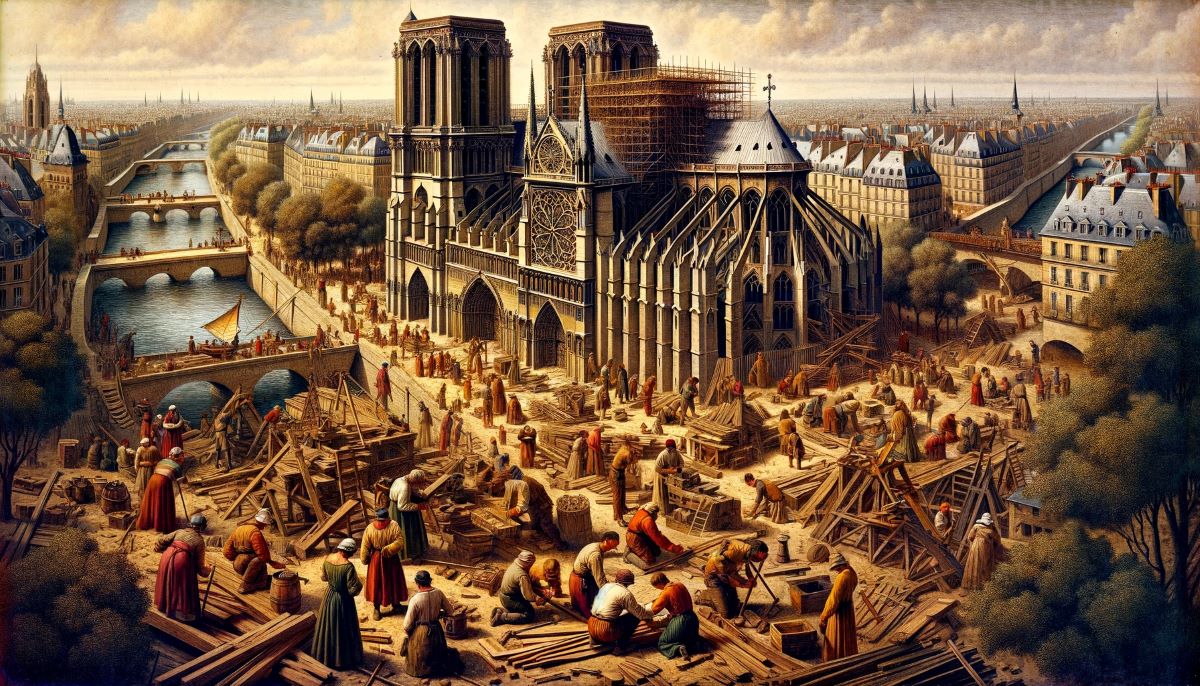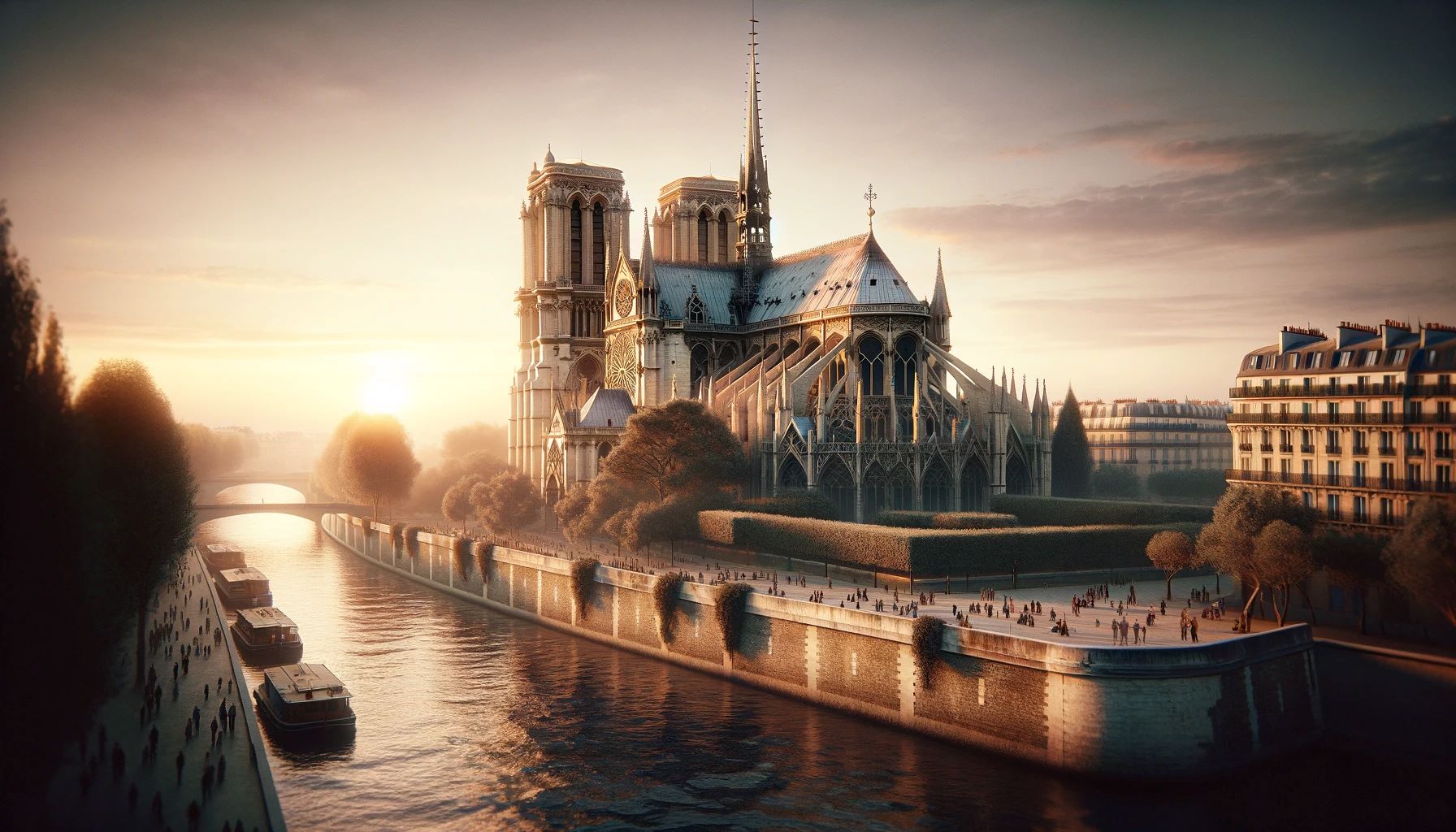Home>Arts and Culture>How Old Is The Notre Dame Cathedral, Paris?


Arts and Culture
How Old Is The Notre Dame Cathedral, Paris?
Published: February 17, 2024
Jason DeRose, Managing Editor at Christian.net, uses his expertise in religion and journalism to deepen understanding of faith's societal impacts. His editorial leadership, coupled with a strong academic background, enriches the platform’s diverse content, earning him recognition in both journalism and religious circles.
Discover the ageless beauty of the Notre Dame Cathedral in Paris, a timeless masterpiece of arts and culture. Uncover the rich history and architectural marvels of this iconic landmark.
(Many of the links in this article redirect to a specific reviewed product. Your purchase of these products through affiliate links helps to generate commission for Christian.net, at no extra cost. Learn more)
Table of Contents
Introduction
The Notre Dame Cathedral, a timeless symbol of Paris, stands as a testament to the city's rich history and architectural grandeur. This magnificent Gothic masterpiece has captured the hearts and imaginations of people around the world for centuries. Its awe-inspiring façade, adorned with intricate sculptures and majestic rose windows, draws countless visitors each year, eager to witness the grandeur of this iconic structure.
The Notre Dame Cathedral, also known as Notre-Dame de Paris in French, holds a significant place in the cultural and religious heritage of France. Its construction, which began nearly 900 years ago, represents a remarkable feat of medieval engineering and craftsmanship. As one gazes upon its soaring spires and majestic bell towers, it's impossible not to be captivated by the sheer scale and beauty of this architectural marvel.
Throughout its long and storied history, the Notre Dame Cathedral has weathered the tides of time, bearing witness to pivotal moments in French history. From royal coronations and religious ceremonies to periods of political upheaval, the cathedral has stood as a silent sentinel, embodying the resilience and enduring spirit of the French people.
The devastating fire that engulfed the cathedral in April 2019 sent shockwaves around the world, sparking an outpouring of grief and solidarity. The images of the iconic spire collapsing in flames left an indelible mark on the collective consciousness, igniting a global movement to restore and preserve this cultural treasure for future generations.
As we delve into the rich tapestry of the Notre Dame Cathedral's history, we embark on a journey through time, exploring the triumphs and tribulations that have shaped this architectural wonder. From its humble beginnings to its enduring legacy, the Notre Dame Cathedral continues to stand as a beacon of hope and resilience, inspiring awe and reverence in all who behold its timeless splendor.
Read more: How Old Is The Paris Notre Dame Cathedral
Construction of the Notre Dame Cathedral
The construction of the Notre Dame Cathedral commenced in 1163 during the reign of King Louis VII and was completed in 1345, spanning over two centuries. This monumental undertaking was led by Bishop Maurice de Sully, who envisioned a grand cathedral that would surpass all others in magnificence and grandeur. The site chosen for the construction was significant, as it was believed to be the location of earlier Roman and Frankish churches.
The architectural design of the cathedral reflected the emerging Gothic style, characterized by its soaring heights, pointed arches, and elaborate sculptures. Skilled craftsmen and laborers toiled tirelessly, employing innovative building techniques to bring Bishop de Sully's vision to life. The use of flying buttresses allowed for the construction of taller walls and expansive stained glass windows, creating an ethereal play of light within the sacred space.
The construction of the Notre Dame Cathedral was a testament to the unwavering dedication and ingenuity of the medieval builders. The intricate stone carvings adorning the façade and the imposing spire, reaching towards the heavens, served as a testament to the spiritual aspirations of the era. The cathedral's interior, with its ribbed vaults and imposing nave, showcased the mastery of Gothic architecture, captivating all who entered its hallowed halls.
The construction of the Notre Dame Cathedral was not without its challenges. The sheer scale of the project, coupled with the limitations of medieval technology, posed formidable obstacles. However, the collective determination of the architects, masons, and artisans propelled the construction forward, resulting in a structure that would endure for centuries to come.
As the final stones were laid and the resplendent rose windows installed, the Notre Dame Cathedral stood as a crowning achievement of medieval architecture, a testament to the unwavering faith and artistic prowess of its creators. Its completion marked the beginning of a new chapter in the history of Paris, as the cathedral's imposing silhouette came to symbolize the spiritual and cultural heart of the city.
The construction of the Notre Dame Cathedral stands as a testament to the enduring legacy of human creativity and determination, a timeless monument to the convergence of art, faith, and ingenuity.
Historical Events at the Notre Dame Cathedral
The Notre Dame Cathedral has borne witness to a myriad of historical events that have shaped the cultural and political landscape of France. From royal coronations and religious ceremonies to periods of turmoil and transformation, the cathedral has stood as a silent sentinel, embodying the resilience and enduring spirit of the French people.
One of the most significant events in the cathedral's history was the coronation of Napoleon Bonaparte as Emperor of the French in 1804. The grandeur of the ceremony, with its opulent pageantry and regal splendor, unfolded within the hallowed confines of Notre Dame, underscoring the cathedral's role as a symbol of imperial power and prestige.
Throughout the centuries, the Notre Dame Cathedral has been a silent witness to pivotal moments in French history. It provided a sacred backdrop for the marriage of Mary, Queen of Scots, to the Dauphin Francis in 1558, forging a union that would have far-reaching implications for the political landscape of Europe.
The cathedral also played a central role in the tumultuous events of the French Revolution. In 1793, amidst the fervor of revolutionary zeal, the cathedral was desecrated, its religious artifacts destroyed, and its sacred statues defaced. The revolutionary fervor sought to erase the symbols of the old order, yet the enduring presence of the Notre Dame Cathedral stood as a testament to the resilience of faith and heritage.
In the aftermath of the devastation wrought by World War II, the Notre Dame Cathedral emerged as a symbol of hope and renewal. Its enduring presence served as a beacon of resilience, inspiring a nation to rise from the ashes of war and rebuild a brighter future.
The devastating fire that engulfed the cathedral in April 2019 sent shockwaves around the world, underscoring the cathedral's enduring significance as a cultural and architectural treasure. The global outpouring of support and solidarity that followed the fire highlighted the cathedral's profound impact on the collective consciousness of humanity.
The Notre Dame Cathedral continues to stand as a testament to the indomitable spirit of the French people and the enduring power of human creativity and resilience. Its storied history, marked by triumphs and tribulations, serves as a poignant reminder of the enduring legacy of this architectural marvel.
Restoration and Renovation Efforts
Following the devastating fire that engulfed the Notre Dame Cathedral on April 15, 2019, a monumental effort to restore and renovate this iconic landmark was set into motion. The blaze, which ravaged the cathedral's roof and caused the collapse of its spire, sparked a global outpouring of grief and solidarity, igniting a determination to preserve this cultural treasure for future generations.
In the immediate aftermath of the fire, a sense of urgency permeated the air as experts and preservationists rallied to assess the extent of the damage and devise a comprehensive restoration plan. The outpouring of support from across the globe, coupled with the unwavering commitment of the French government and cultural institutions, underscored the cathedral's profound impact on the collective consciousness of humanity.
The restoration efforts commenced with a meticulous assessment of the structural integrity of the cathedral. Teams of architects, engineers, and conservationists meticulously surveyed the site, documenting the damage and formulating a strategy to stabilize the structure and prevent further deterioration. The delicate task of removing debris and reinforcing weakened sections of the cathedral required a delicate balance of precision and expertise.
One of the most critical aspects of the restoration efforts was the preservation of the cathedral's priceless artifacts and religious relics. A herculean endeavor was undertaken to salvage and protect these irreplaceable treasures, underscoring the unwavering commitment to safeguarding the cultural heritage embodied within the hallowed walls of Notre Dame.
As the restoration efforts gained momentum, a wave of international support poured in, with pledges of financial assistance and expertise from individuals, corporations, and governments. The global community's collective determination to aid in the cathedral's restoration underscored the profound significance of Notre Dame as a symbol of human achievement and cultural heritage.
The restoration and renovation efforts also embraced innovative technologies and sustainable practices, ensuring that the cathedral would be restored to its former glory while incorporating modern advancements in architectural conservation. The meticulous process of sourcing materials and employing traditional craftsmanship paid homage to the centuries-old techniques that had originally brought the cathedral to life.
The restoration and renovation of the Notre Dame Cathedral stand as a testament to the resilience and determination of the human spirit. As the cathedral rises from the ashes, it embodies a beacon of hope and renewal, inspiring future generations with its timeless splendor and enduring legacy.
Current State of the Notre Dame Cathedral
The Notre Dame Cathedral, a revered symbol of Paris, stands today as a testament to the resilience and unwavering spirit of the French people. Following the devastating fire that engulfed the cathedral on April 15, 2019, a monumental effort to restore and renovate this iconic landmark has been underway. The current state of the Notre Dame Cathedral reflects a convergence of determination, expertise, and global solidarity as the restoration endeavors continue to unfold.
At present, the cathedral stands shrouded in scaffolding, a visible testament to the extensive restoration work taking place. The painstaking process of stabilizing the structure and assessing the extent of the damage has been a focal point of the restoration efforts. Teams of architects, engineers, and conservationists have meticulously surveyed the site, documenting the intricate details of the cathedral's architecture and formulating a comprehensive strategy to ensure its preservation for future generations.
The restoration of the Notre Dame Cathedral also encompasses the delicate task of salvaging and preserving its priceless artifacts and religious relics. Every effort has been made to protect these irreplaceable treasures, underscoring the commitment to safeguarding the cultural heritage embodied within the hallowed walls of Notre Dame.
The global outpouring of support and solidarity following the fire has been instrumental in propelling the restoration efforts forward. Pledges of financial assistance and expertise from individuals, corporations, and governments around the world have underscored the cathedral's profound impact on the collective consciousness of humanity. This outpouring of support has not only provided crucial resources for the restoration but also serves as a poignant reminder of the cathedral's enduring significance as a cultural and architectural treasure.
As the restoration and renovation efforts continue to unfold, the Notre Dame Cathedral stands as a beacon of hope and renewal, inspiring future generations with its timeless splendor and enduring legacy. The ongoing work serves as a testament to the resilience and determination of the human spirit, ensuring that this architectural masterpiece will continue to inspire awe and reverence for centuries to come.















